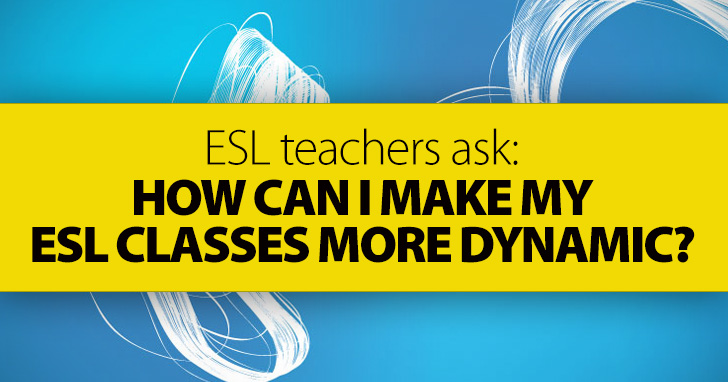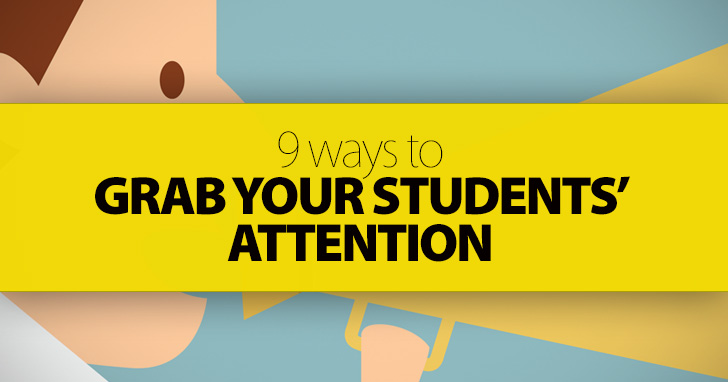ESL Teachers Ask: How Can I Make My ESL Classes More Dynamic?


As technology runs faster, our attention spans get shorter. Remember what it was like to have to wait several minutes for a web page to load? There are students who’ve never experienced that. From the moment they were born, they’ve been exposed to things that move at an alarming speed. They click through websites faster than we ever flicked through a magazine in our youth. They type text messages with dizzying speed, their thumbs clicking on the keys to rapidly shoot off one message after another. Meanwhile, in your ESL classroom, things move considerably slower. You ask a question and a student takes his/her time to answer. There’s a silence while you patiently wait. And so students’ minds start to wander, their fingers itching to tap on their phones to see if someone’s posted any news on Facebook.
So how can you grab their attention and hold it for the duration of the class?
It might seem like mission impossible, but there are a few tricks you may want to try.

One of the simplest ways to grab your students’ attention is to simply walk around the classroom. All the time. Stand next to students if you see them reach for their phones. Move to the back of the classroom. Students need to feel that there is no place for them to hide and slack off while you teach.
Too many students are accustomed to a specific classroom setup. The best students sit in the front. The shier ones sit in the back where they “hide”. Do away with these physical constraints! Have them all sit in a circle on the floor. Or arrange their desks in a circle. Shake them out of their accustomed structure, and they will pay attention. For they won’t know what comes next.
And speaking of not knowing what comes next… Students may wander more easily when they know what to expect and what will happen next. They come in and sit down. You ask them if they did their homework. You tell them to open their books. But what if instead of beginning the class the way you usually do, you do something completely unexpected? What if you show them a video first? They’ll certainly be intrigued!
Sometimes you have no choice. Sometimes you have to enforce a “no cell phone” rule. However, they may still need them to take photos or film videos during class. So, simply ask them to deposit their phones in a designated box at the start of class and give them back as needed. Yes, they will complain. No, they won’t like it. But if you engage them with activities they enjoy, they’ll forget about their little tech gadget for a while.
Have them do what you would ordinarily do. Have a student write on the board, have another hand out worksheets, and yet another help a classmate with something they don’t understand.
Students are forced to focus when they can’t hide within a larger group. Divide the class into pairs or small groups for some activities. Walk around and assist as needed.
Change your tone of voice as often as you can. Whisper something, then SAY IT LOUD. (Ever see students jump out of their seats?) Use different accents if you can, I highly recommend it. Students get a real kick out of it, and it really makes them listen up.
Grab a small, soft ball. Ask a question and toss the ball to a student. Prompt him/her to answer your question. Have them throw the ball back to you and choose your next target. Who will be next? They won’t know! Use balls, hats, toys, anything and everything that will make a drilling session more interesting and dynamic.
Have a box with the word “Box of Randomness” written on the side. Inside the box have pieces of paper with a variety of actions and things your class will have to do. At any given time during the class, whip out the box and have a student take out a piece of paper that will state something that he/she or the entire class will have to do. You may want to save this box for when you see someone not paying attention. Here are some ideas for your Box of Randomness:
You can have lots of fun with your Box of Randomness, and it’s a great “penalty” for not paying attention.
ESL students are not automatically engaged just because they need to study English. It’s up to us to engage them!
Increasingly so, students come to us wired with short attention spans. It’s our job to try our best to grab and hold their attention. What’s in it for you? The satisfaction of knowing you are more interesting than anything that’s going on in Facebook. And how wonderfully satisfying that is!
* This question was sent in from a real ESL teacher, just like you! If you need any advice on a particular topic, share your question in the comments below. Or tweet your question to @busyteacher_org with the hashtag #ESLTeachersAsk. Your question might get picked and featured in an article!